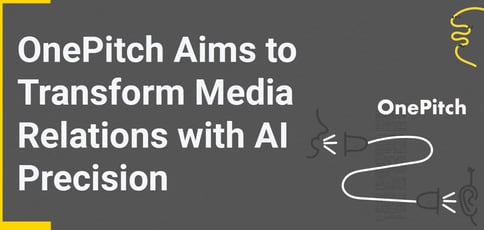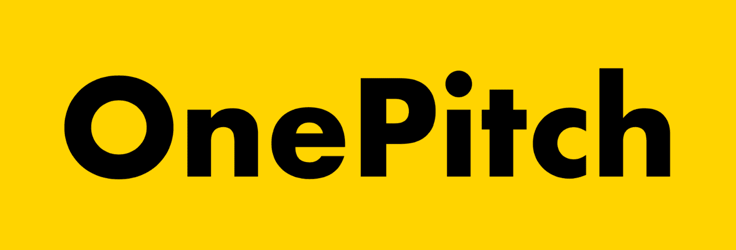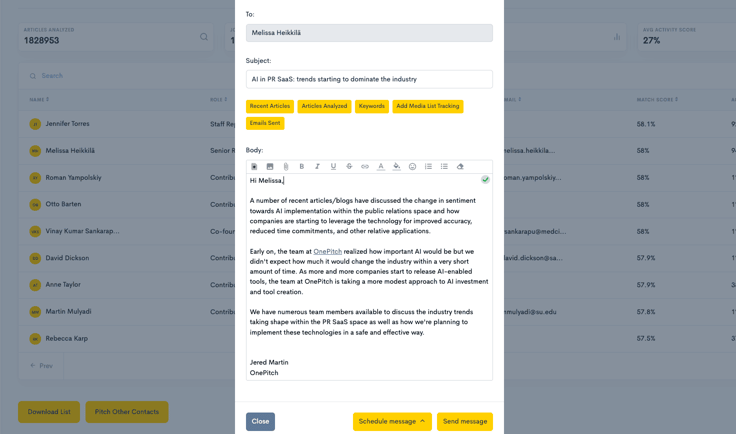
TL; DR: Welcome to the marketing world, where pitching a story idea to a journalist usually involves what some may describe as a delicate song and dance. The good news is OnePitch is here to streamline the process. Jered Martin, Co-Founder and COO, sheds light on how it simplifies story idea pitching by leveraging its patent-pending artificial intelligence (AI) software to automate routine tasks such as research, writing, and outreach.
To anyone who’s ever had to write a news pitch, I feel for you. There is almost nothing more agonizing than blank eyes staring back at you as you unveil your fresh idea. But it’s a whole new ballpark when pitching story ideas to the media is a part of your daily life, yet almost all of them go unnoticed.
In the marketing world, there are six times as many public relations (PR) professionals as there are journalists — so there has to be an innovative way to rise above the noise.

This is where OnePitch comes in. OnePitch is a PR software that allows your team to automate and streamline every aspect of the pitching process, from researching and writing to building relationships and tracking results.
Jered Martin, Co-Founder and COO, explained the company’s mission to make the PR-journalist connection more compelling. “From day one, our goal has been to ensure journalists receive relevant pitches and that publicists craft pitches that are both clear and concise yet meaty enough to capture their attention.”
Inside the OnePitch Formula
OnePitch is designed to pair your news pitch with news outlets and journalists who want your story.
“We approached this process much differently than all of our competitors where they’ve taken this traditional approach where you go to a database, type in some key terms, and sift through pages upon articles that mentioned the word you’re searching for,” Jered explained. “We’re essentially taking that process and reversing it.”
Here’s how it works: Start with the pitch template where you’ll input the pitch title, brand, hyperlink, pitch content, and its significance. The platform employs an AI-powered approach beyond automating outreach lists, fostering enhanced connections between publicists and journalists.
The Pitch Checker system analyzes numerous data points to identify journalists who are most inclined to cover a particular pitch. After submitting a pitch, users can click “Find Journalist Matches” to receive a list of journalists, each accompanied by a match score, an activity score, and a list of keywords that match your pitch.

You also get automated insights into how the pitch might be perceived, offering suggestions for improvements, including subject line length, sentence structure, attention-grabbing phrases, and relevant terms. It even assesses contextual elements, such as avoiding sounding overly promotional.
Jered emphasized every aspect of this process is because of actual feedback they’ve received from real marketers and PR professionals.
“We strongly believe they’re in the trenches who know this better than anybody. Our job is to listen to them, take those learnings, and figure out how to apply it to the platform, ultimately making that experience more cohesive, seamless, and natural,” Jered said — and then added, “There’s nothing more rewarding than building something that somebody asked for.”
Save Time, Automate Your Pitches
Marketers and publicists spend an average of 16 hours per week doing manual tasks that encompass researching, compiling lists, analyzing results, creating and sending emails, and updating relevant information.
Conversely, journalists face an average of 20 to 30 cold pitches daily. And on top of that, they’re losing the chance to connect with people who could bring value to their work.
“Knowing more responsibilities are falling on the shoulders of these professionals makes it that much more important that we’re able to automate these tasks using a certain type of technology, whether with AI or natural language processing,” said Jered.
To help alleviate this, OnePitch helps create clear and concise pitches while coaching marketers and publicists on how to create an effective one and how it compares to other pitches within the space.
“All news stories have a certain type of angle just as outlets have a particular audience they’re addressing,” Jered said. “So we’re trying to marry the angle with the audience and allow our end users to identify the right people they want to connect with.”
Instead of sifting through hundreds of pages, you can narrow your search with a typical maximum of around 50 people. Easily apply filters to refine the list and focus on specific criteria such as outlet types (newspapers, magazines, podcasts) and journalist types (reporters, editors, freelancers).
But OnePitch isn’t just a platform that helps you write stellar pitches; it’s also a coaching device.
“We’ve built in some of these reminders into the system that shows people how to adopt better practices, which is especially helpful for those folks that maybe this isn’t their full-time role, or this is the first time that they’re doing it and they don’t exactly know yet,” Jered said.
For instance, OnePitch offers automatic reminders to follow up with journalists who haven’t responded within a specified time frame.
The Future of OnePitch
Jered and OnePitch approach AI with careful consideration to navigate the delicate balance between automation and human contact.
Jered recognizes automation can do pretty much anything, whether it’s sifting through mass amounts of data and creating an outreach list or pulling insights from how journalists may perceive your pitch.
In the case of OnePitch, AI can also quickly pull relevant information that allows you to put a personal touch on each pitch, which Jered predicts will be the norm soon enough.
“Personalization is going to go beyond just making sure that you have the person’s name and that you’ve attributed your message to what they write about,” he said. “I think there will continue to be unique ways professionals adopt different techniques and technologies to do that.”

So, what’s next? The OnePitch vision goes beyond securing an article. It also plans to emphasize a greater focus on end-to-end workflow automation and insights by addressing questions such as:
- How did your pitch and its article perform?
- How did it reach people, and what was the engagement rate?
- Is there any return on investment (ROI) that can be attributed?
OnePitch is ultimately focused on providing whatever it can to help its customers make their work lives more manageable.
“I’m very much looking forward to continue working closely with our community to hear about what else we can do, what we can do better, and what we can improve upon,” Jered said.
“End bad pitches. Start great stories.” That’s the OnePitch mantra — so if you’re ready, check out OnePitch today.



